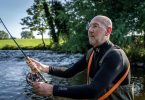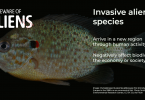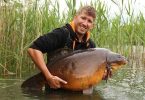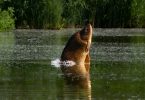The Angling Trust and the Institute of Fisheries Management held a workshop at Barston Lakes in the Midlands for academics, Defra, the Environment Agency and fisheries and angling groups to assess the impacts of growing numbers of otters on fisheries and to identify actions to minimise them.
 The workshop heard that the resurgence of otter numbers has been almost entirely driven by natural regeneration as a result of the withdrawal of harmful chemicals in the 1970s and 1980s. Genetic evidence shows that the offspring of captive-bred otters, released up until the 1990s, have not moved very far from the Midlands. The only otters released since then have been wild-born injured or orphaned animals which have been rehabilitated in sanctuaries.
The workshop heard that the resurgence of otter numbers has been almost entirely driven by natural regeneration as a result of the withdrawal of harmful chemicals in the 1970s and 1980s. Genetic evidence shows that the offspring of captive-bred otters, released up until the 1990s, have not moved very far from the Midlands. The only otters released since then have been wild-born injured or orphaned animals which have been rehabilitated in sanctuaries.
Although official surveys have a low level of confidence about the numbers of otters nationwide, there is consensus that numbers are growing and they are becoming more widespread. In some areas, they may have reached a maximum population.
There were presentations on the impact of otters on river and still water fisheries and on trout farms which demonstrated significant losses in some parts of the country. However, there were many healthy fisheries in places where otters were present in significant numbers. Environmental pressures on rivers such as pollution, over-abstraction, habitat damage and invasive species were heard to have a major impact on the recruitment of many fish populations and there was consensus that urgent action was needed to tackle these problems.
While more and more fisheries are being fenced due to funding from the Environment Agency’s rod licence distributed by the Angling Trust, there is a huge demand for fencing and costs have increased in recent years. Many fisheries cannot be fenced and there is a need to explore the potential for other deterrents to predators at these fisheries. Many fisheries may have to adapt their fishery management and stock balance to reflect the rising numbers of otters.
Mark Lloyd, Chief Executive of the Angling Trust and Fish Legal said: “There is no doubt that there have been very significant problems on many still water and river fisheries as otters have spread into new areas. Fishery management will have to adapt to the presence of otters over the coming years as they reach their natural balance and our organisations are committed to doing everything we can to support clubs and fisheries through that process. Urgent action is needed to tackle the many environmental threats to rivers and lakes to ensure that fisheries can be more resilient to predation.”
David Bunt, Chairman of the Institute of Fisheries Management said: “It has been very positive to get the experts and representatives of angling and fisheries and otter science together to have a rational, informed and balanced debate. Healthy fish stocks and fishing are an indication of healthy environments and can co-exist with healthy otter populations. Where fish are concentrated they will be targeted by otters and, to protect those fisheries and businesses that rely on them, we will support non-harmful methods to deter otters from entering them.”
Key Outputs
1. The Angling Trust and IFM will produce a guide for angling clubs and fishery managers setting out the legal situation, correcting some of the misunderstandings around releases and captive bred otters and what can be done to protect fish stocks against otter predation.
2. The Angling Trust and IFM will request the statutory agencies to streamline the consent processes for permitting otter fencing on still waters and press for an increase in funding.
3. The Angling Trust will lobby the government for the long-term regulation of the rehabilitation of injured and orphaned otters and a Code of Conduct in the short-term.
4. The Angling Trust and IFM will press for further research to be commissioned into deterrents for unfenceable waters.
5. The Angling Trust and IFM will press for clarification regarding scaring or disturbing an otter as a result of either protecting a legitimate business or installing in stream habitat enhancements.
6. All agreed that more action was needed to deal with the issues affecting recruitment of river fish: pollution, abstraction, habitat damage, barriers to fish migration. A more healthy fish population would be better placed to withstand the impacts of otter predation.
7. The Environment Agency is planning a series of workshops and a conference around management of still water fisheries over the coming year that will provide guidance around designing resilience to predation.








